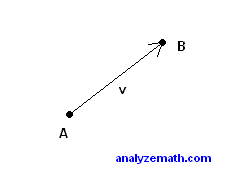
Tutorials including examples with detailed solutiond on the addition and scalar multiplication of vectors are presented.
Vectors are mathematical quantities used to represent concepts such as force or velocity which have both a magnitude and a direction.
The figure below shows vector v with initial point A and terminal point B.

The component form of vector v with initial point A(a1,a2) and terminal point B(b1,b2) is given by
If a vector is given by its components v = < v1 , v2 > , it magnitude || v || is given by
The scalar multiplication of vector v = < v1 , v2 > by a real number k is the vector k v given by
k v = < k v1 , k v2 >
The addition of two vectors v(v1 , v2) and u (u1 , u2) gives vector
v + u = < v1 + u1 , v2 + u2>
Below is an html5 applets that may be used to understand the geometrical explanation of the addition of two vectors. Enter components of vectors A and B and use buttons to draw, add, zoom in and out as well as translate the system of axes.
Example 2: Vectors v and u are given by their components as follows
v = < -2 , 3> and u = < 4 , 6>
Find each of the following vectors.
1 : v + 2 u
2 : u - 4 v
Solution to example 2:
First carry out the scalar multiplication 2 u then the addition
1 : v + 2 u = <-2 , 3> + 2 <4 , 6> = <-2 , 3> + <8 , 12>
= <6 , 15>
2 : u - 4 v = <4 , 6> + (- 4) <-2 , 3> = <4 , 6> + <8 , -12>
= <12 , -6>
Example 3: v and u are vectors given by
v = < 1 , -2> and u = < u1 , u2>
Find components u1 and u2 of vector u so that v + 3 u = 0.
Solution to example 3:
We first obtain v + 3 u in terms of u1 and u2
v + 3 u = <1 , -2> + 3 <u1 , u2>
= <1 , -2> + <3 u1 , 3 u2>
= <1 + 3 u1 , -2 + 3 u2>
For the above vector to be equal to vector 0, its two components have to be equal to 0, hence
1 + 3 u1 = 0 and -2 + 3 u2 = 0
Solve the first equation for u1 and the second equation for u2
u1 = -1 / 3 and u2 = 2 / 3
Exercises
1. Given vectors
v = <-3 , 2> and u = <-2 , 0>,
find the following vectors.
- v + 2 u , v - (1/2) u
2. Vectors v and u are given by
v = <4 , 1> and u = <u1 , u2>,
find components u1 and u2 so that 2 v - 3 u = 0 .
Answers to above exercises
1.
- v + 2 u = <- 1 , -2>,
v - (1/2) = <- 2 , 2>,
2.
u1 = 8 / 3
u2 = 2 / 3
Home Page